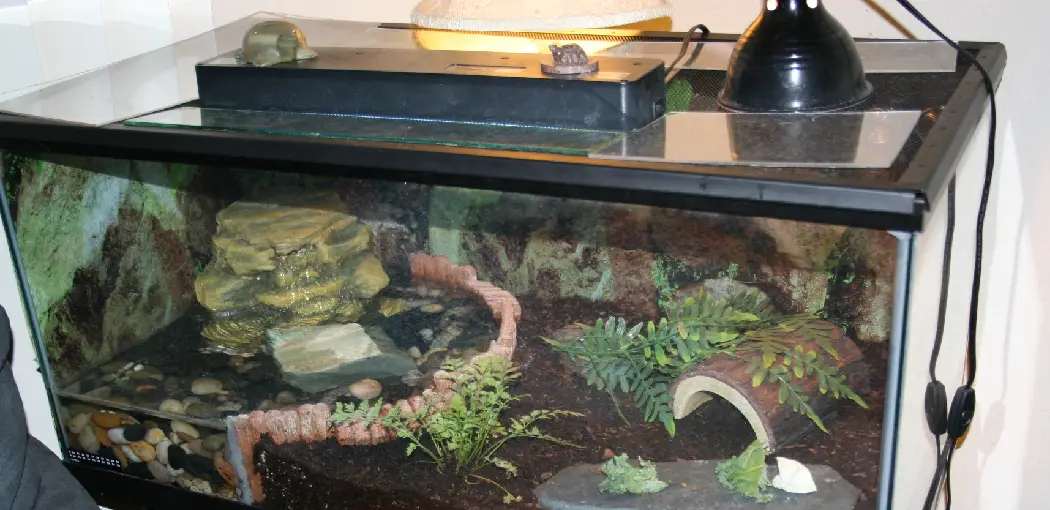If you’re looking to give your bearded dragon or another reptile a bit of extra ultraviolet light, you may be wondering how to mount uvb light in tank. It’s not difficult, and there are a few different ways to do it. In this post, we’ll show you three methods for mounting uvb light in a tank to choose the one that works best for you. Let’s get started!
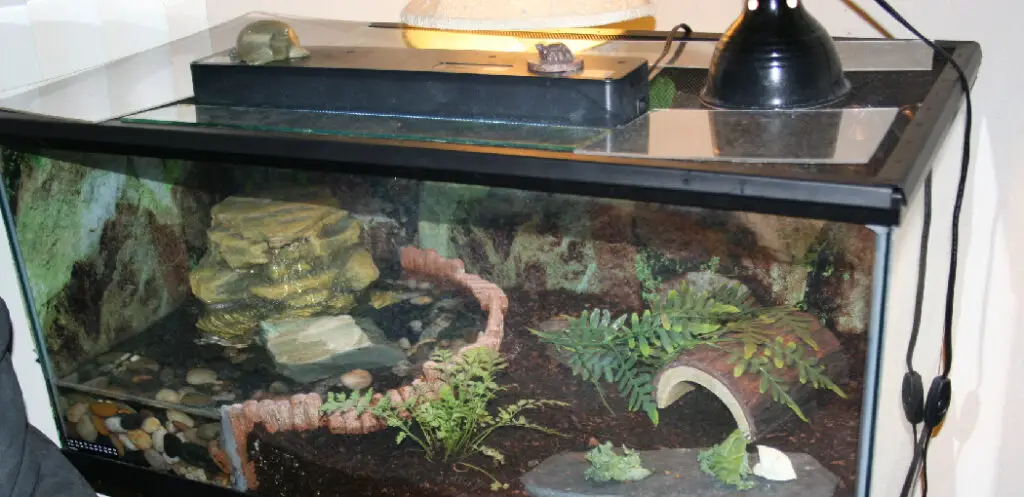
Uvb lights are a great way to give your bearded dragon, gecko, or another type of reptile the ultraviolet light they need. But to provide them with this light, they need to be able to use it. Mounting uvb light in a tank is pretty easy if you have the right equipment.
Summary: Mounting a UVB light in a tank is essential for the health and well-being of reptiles and amphibians, as these animals require exposure to ultraviolet B (UVB) radiation for proper calcium metabolism and bone development. To ensure that your pet receives adequate UVB exposure, it is crucial to install the UVB light correctly within their tank or terrarium. There are various mounting options available, such as clamp lamps, fluorescent tube fixtures, and adhesive or magnetic mounting brackets, depending on your tank setup and the type of UVB light you have chosen.
To mount a UVB light in a tank, first, select the appropriate mounting hardware and fixture for your chosen UVB light source, ensuring that it is compatible with your tank’s dimensions and materials. Follow the manufacturer’s guidelines for installation, which typically involve attaching the fixture to the top or side of the tank. For clamp lamps, secure the clamp to the rim or a sturdy brace, positioning the light to provide even UVB coverage across the basking area.
For fluorescent tube fixtures, use adhesive or magnetic mounting brackets to attach the fixture to the interior or exterior of the tank, depending on your tank’s design and the fixture’s compatibility. Ensure that the UVB light is positioned at the recommended distance from the basking area, as specified by the manufacturer, to provide the appropriate level of UVB exposure for your pet. Finally, connect the UVB light to a power source and establish a proper day-night cycle that mimics the natural conditions of your pet’s habitat. By correctly mounting a UVB light in your pet’s tank, you can support their health and create a comfortable, thriving environment for them.
What Is UVB Light?
Uvb light is a special light that emits ultraviolet rays. Although it doesn’t emit any visible photons, fishes and aquatic plants need this kind of rays to survive well. So, using an uvb tube, we can create our uvb source for our aquarium.
Uvb light provides the necessary energy for a clawed frog to produce vitamin D3. Vitamin D3 is essential because it allows the frog to absorb the calcium from its surroundings and store it in its body, providing strong bones and acting as a preventative measure against metabolic bone disease.
Without uvb light, a captive frog’s diet would need to consist of food items high in calcium content. This would not only be cost-prohibitive to the frog keeper, but it would also be impractical if a suitable diet weren’t available.
Uvb light is not harmful to humans or animals. Uvb light emits the highest energy levels in the 290-320 nanometer wavelength, visible to amphibians, reptiles, and fish. Uvb light also emits low levels of UVB radiation in the 315-400 nanometer wavelengths required for Vitamin D synthesis in birds and mammals.
***
Things You’ll Need:
- Fluorescent UVB Lamp 4 ft.(120cm) F15T8-HO or T12
- Aquarium Stand/Cabinet
- Aquarium Sealant
- Shallow water tray(optional)
- Sterilized Gravel, Sand, or Borrowed Substrate
A Stepwise Guide on How to Mount UVB Light in Tank
Step 1: Determine the Location
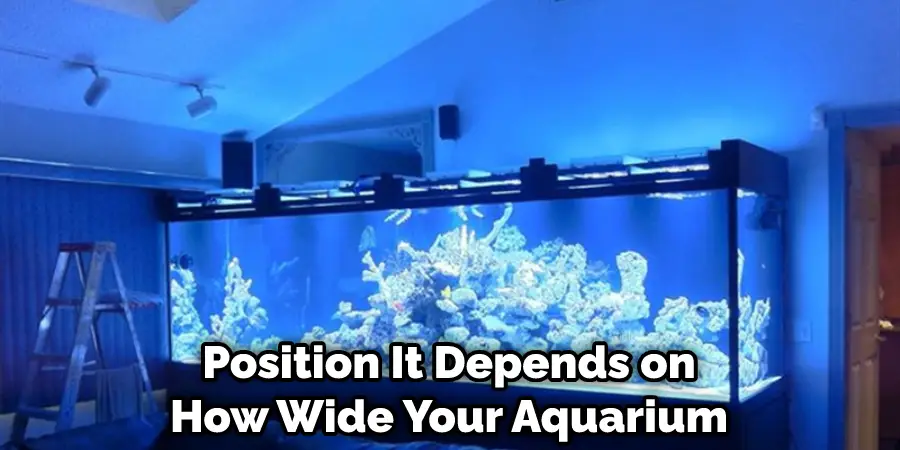
The best location for the lamp is on one side of your fish tank. How far away you should position it depends on how wide your aquarium is. Since fluorescent lamps emit UVA and UVB rays, they need to be positioned no less than 30 cm (12 inches) away from their surface. For example, if your aquarium is 60cm wide, place it at least 30cm away from the front glass pane of the fish tank wall.
Step 2: Determine How High You Should Mount It
For UVA rays to reach all parts of your fish tank, the light should be mounted above the water line to spread out across the top of it without hitting any obstructions like rocks or trees. The suggested distance is 20 cm away from the water’s surface. How high you should mount the light depends on how tall your fish tank is. For example, if it is 40cm in height, you need to place it approximately 20 cm above the waterline.
Step 3: How Far Should You Place It From Your Fish?
The UVA and UVB rays are not that strong when they have just entered your aquarium, so there won’t be any harm if your fish come in direct contact with them for a few minutes during inspection or feeding time.
But having said that, it doesn’t also mean that they can stay beside their source all day long since prolonged exposure still has adverse effects on them, leading to serious health problems like blindness, bulging eyes, skin diseases, and blindness.
How far you should space your fish from its source is a matter of personal preference but make sure they are at least 10cm away from it. It depends on how big your aquarium is. If it is 80cm long, you need to place the lamp at least 10 cm away from the front glass pane of the tank’s wall.
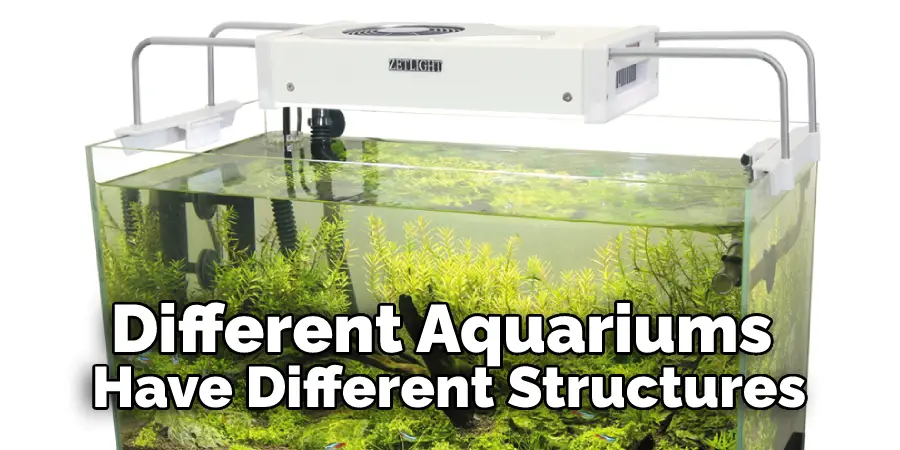
Step 4: Mount-It!
Different aquariums have different structures. How you mount your lamp will depend on the material used for your fish tank, in a way that it should be secured in a way to make sure it won’t fall when mounted. There are two types of mounts:
1. Bracket/Cage Mounting
2. Clip-On Mounting
There are two main types of aquarium mounts: bracket or cage mounts, which are more permanent and usually made from metal; and clip-on mounts, which are less permanent but easier to attach and detach from the glass pane(s) of an aquarium’s wall(s). Clip-on mounts are just a plastic hook with two suction cups at each end. To clip-on mount, push one cup against one side of your aquarium’s glass pane, then attach the other cup to the opposite end.
Mounting is just putting it on top of your fish tank without attaching it to its wall(s). How far you place it away from the waterline depends on your aquarium’s vastness. For example, if it is 60 cm, make sure you put the light at least 30cm away from the front glass pane of your fish tank’s wall.
Step 5: Connect The Cord
Connecting the lamp to a power supply also depends on its design and material. Fluorescent lights, like most electrical devices these days, use either a 120-volt AC (alternating current) or a 240V AC power supply system. How you connect it to an aquarium’s electric socket depends on where your fish tank is located – within sight of an outlet or too far from one.

Since fluorescent lights require more watts than other lighting systems, wire gauge size is usually more significant than those used for incandescent and halogen bulbs, so make sure that the one you choose can handle at least ten amps before purchasing them.
Step 6: Sealant Time
After you’ve decided on the perfect location for your fish tank, how high to mount it, and how far away from your fish to place it, it’s time to seal the area with marine-grade aquarium sealant. Once all that work is done, don’t forget to check for any leaks in your glass tank. One way to tell if there’s an undetected leak is if the water level goes down overnight or evaporates too quickly.
Use a reliable fish tank leak detector like bromothymol blue to know if you already leak to avoid wasting your time and efforts. Using bromothymol blue is by dipping a cotton bud or tissue with this solution on it and putting it inside your tank overnight. If the paper has turned green, then there’s no leak.
But if it stays white, you better call a professional to repair your aquarium as soon as possible because it may not hold water again, which could mean big trouble for your fishes and aquatic plants once they get too dry and die.
Step 7: Maintain It
Although light bulbs don’t last forever, some can last much longer than others. It all depends on the brand and quality of the bulb. You can usually find this information on the packaging, or by asking someone who has used that type of light bulb before. In general, number 40 or 60 bulbs can last for more than two years, while 150-watt lamps may last up to 6 months only.
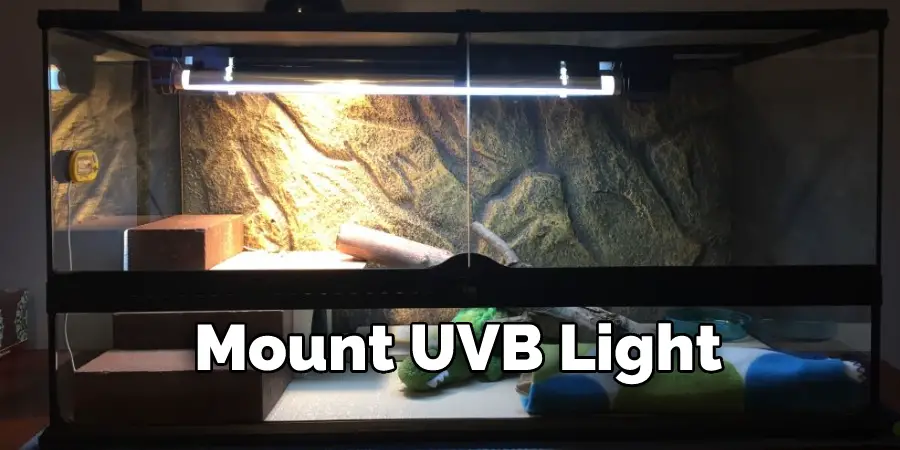
So check your fish tank’s lighting system regularly, especially before feeding time, so you’ll know if they need replacement soon or not. Let all your fishes gather at the front glass pane of the aquarium where they get their food, then switch on the lamp. If most of them are collected within a few minutes without your fish feeder giving any treats, then it means that your tube is still bright enough to let them enjoy their meal. These steps will help in how to mount uvb light in tank.
You Can Check It Out to: Mount a Light on Uneven Stone
Additional Tips:
1. It is usually good to place the fluorescent bulb within a hood for safety purposes and direct the light in a more specific direction rather than let it shine in all orders.
2. Light exposure should be limited to no more than 10-12 hours a day, allowing fish to rest.
3. The uvb light should always be positioned above water level so that carbon dioxide can be released into the air or dissolved into the water without blocking or preventing the penetration of uv rays from reaching your fish and aquatic life. Moreover, it is recommended to position it above a surface rather than below one because too much exposure to ultraviolet rays may cause damage to aquarium equipment such as pumps and filters if placed at a direct distance with these objects.
4. How often you should change your Fluorescent UV-B tubes will depend on how hot they are when turned off after use. The hotter the tube is, the faster it will degrade. Therefore, you should always replace your tubes at least once a year to avoid health problems in your fish and aquatic life.
5. How far above water level you position your uvb light depends on how many watts each tube emits and the lighting design that you have for your aquarium or fish tank.
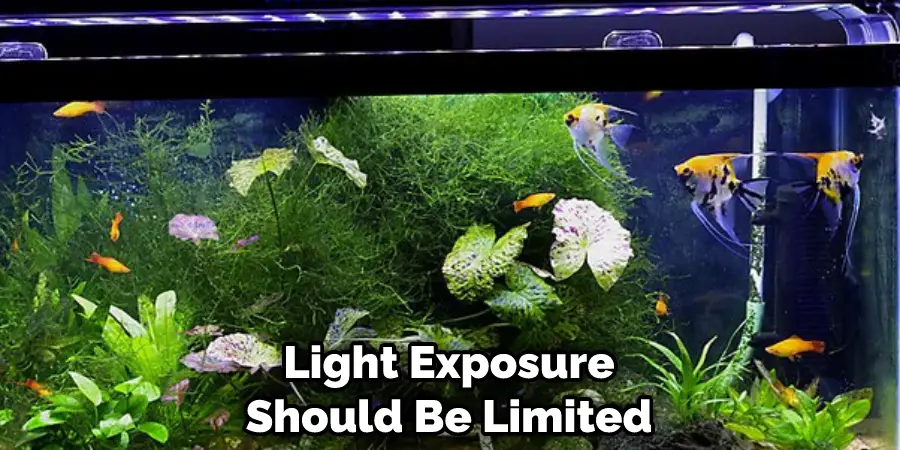
You Can Check It Out to: Use the Light Keeper Pro
Frequently Asked Questions
Where Do You Put the UVB Light in a Vivarium?
A uvb light can be used in a vivarium to help simulate the sun’s ultraviolet (uv) radiation. This type of lighting is essential for species such as lizards and amphibians, which do not have access to direct sunlight.
UVB lights emit shortwave ultraviolet (uva and uvv) radiation that stimulates the production of vitamin D in these creatures. Vivariums without artificial sources of UV rays are likely to suffer from deficiencies in this important nutrient, which can lead to health problems including skin cancer and reduced immune function.
If you want to install a uvb light in your vivarium, it’s best to put it on an overhead console or bracket. That way, it will give all parts of the enclosure a broad area of exposure. You might also need accessories, like collars or hoods, to block out harmful blue light from things like computer monitors and other electronic equipment. And remember, always keep your windows screened when you can’t turn off lights at night!
Does UVB Go Through Mesh?
Yes, UVB does go through mesh. However, it is important to be cautious when using mesh as there is a possibility of exposure to harmful radiation. Properly shielding your skin with clothing and sunglasses will help minimize the risk of health concerns related to UVB exposure.
Can Bearded Dragons Get Too Much UVB?
Yes, bearded dragons can get too much UVB. Bearded dragons have specialized skin that helps them absorb UVB radiation and converts it into usable vitamin D3. This allows the beards to produce yellow body scales and a bushy “beard”, which comes in handy for locating food and mates during the day! However, too much UVB radiation can be harmful to bearded dragons. Prolonged exposure to high levels of UVB radiation can cause skin cancer and other health problems.
However, excessive exposure to UVB radiation can cause sunburns on the lizard’s skin as well as some genetic defects in their offspring. So make sure you are providing your dragon with adequate sunlight when necessary and avoid over-exposure whenever possible.
Does UVB Go Through Plexiglass?
There is no definitive answer to this question since it depends on a number of factors, including the thickness, type, and brand of plexiglass, the intensity of the UVB light source, and the angle at which the light is directed.
In general, however, UVB light should pass through most types of plexiglass.
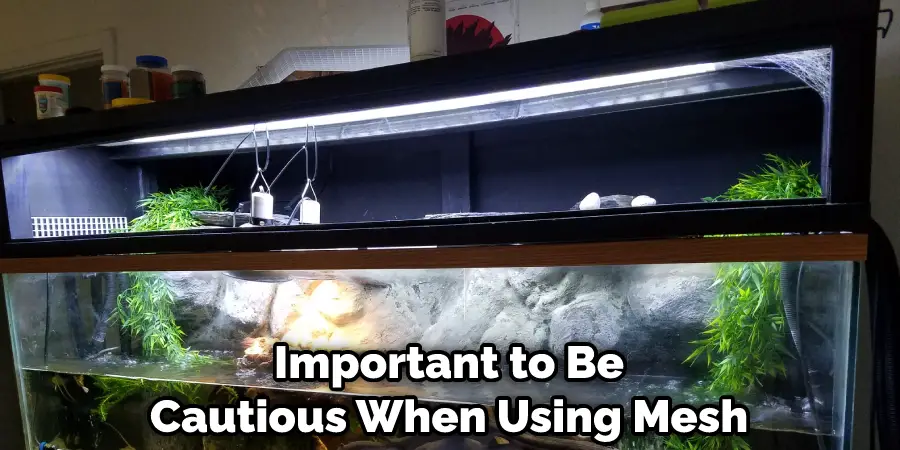
Conclusion
When you are finished mounting your Uvb light, it is essential to consider the following things. First, make sure that your light faces south or southeast so that there are no shadows cast on the tank wall from trees outside the window. Mounting lights too high can make them ineffective. We hope you have learned how to mount uvb light in tank.
You Can Check It Out To Wire String Lights Together
